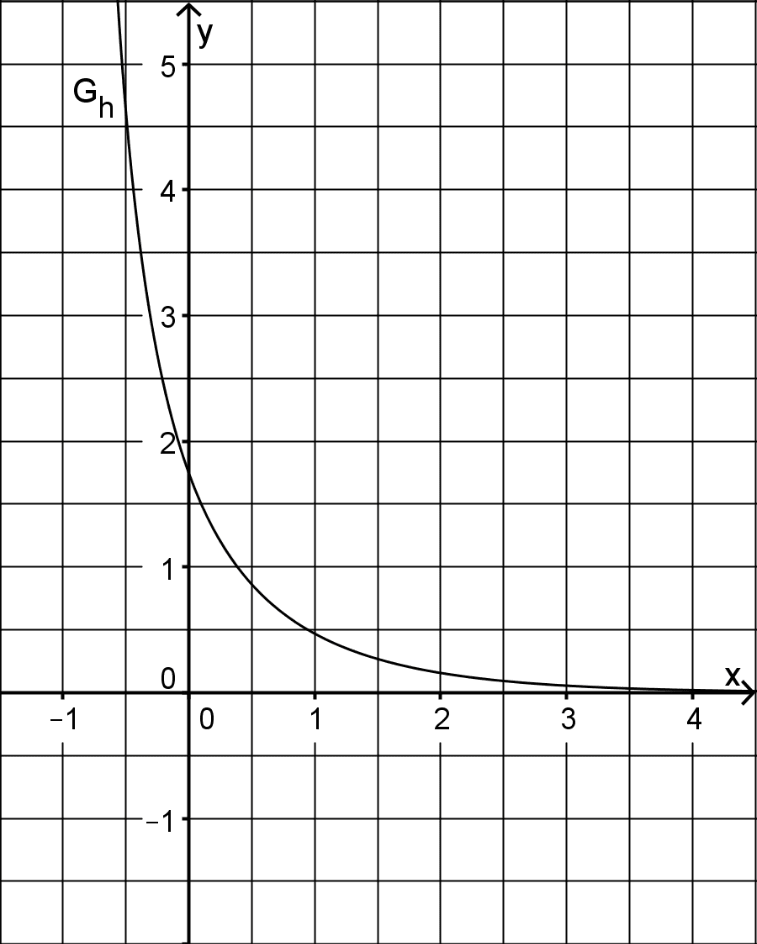Gegeben ist die Funktion \(\displaystyle h \colon x \mapsto \frac{3}{e^{x + 1} - 1}\) mit Definitionsbereich \(D_{h} = ]-1;+\infty[\). Abbildung 2 zeigt den Graphen \(G_{h}\) von \(h\).
 Abb. 2
Abb. 2
Begründen Sie anhand des Funktionsterms, das \(\lim \limits_{x \, \to \, +\infty} h(x) = 0\) gilt.
Zeigen Sie rechnerisch für \(x \in D_{h}\), dass für die Ableitung \(h'\) von \(h\) gilt: \(h'(x) < 0\).
(4 BE)
Lösung zu Teilaufgabe 2a
Grenzwertbetrachtung (Verhalten im Unendlichen), Vorzeichen der 1. Ableitung
\[h(x) = \frac{3}{e^{x+1} - 1}\,; \enspace D_{h} = \; ]-1; +\infty[\]
Begründung, dass \(\lim \limits_{x\,\to\,+\infty} h(x) = 0\) gilt
\[\lim \limits_{x\,\to\,+\infty} h(x) = \lim \limits_{x\,\to\,+\infty} \frac{3}{\underbrace{e^{x+1} -1}_{\to\,+\infty}} = 0 \]
Nachweis, dass für die Ableitung \(h'\) von \(h\) gilt: \(h'(x) < 0\)
Ableiten nach der Quotientenregel:
\[h(x) = \frac{3}{e^{x+1} - 1}\,; \enspace D_{h} = \; ]-1; +\infty[\]
Quotientenregel
\[ f(x) = \frac{u(x)}{v(x)} \quad \Longrightarrow \quad f'(x) = \frac{u'(x) \cdot v(x) - u(x) \cdot v'(x)}{[v(x)]^2}\]
Kettenregel
\[ f(x) = u(v(x)) \quad \Longrightarrow \quad f'(x) = u'(v(x)) \cdot v'(x) \]
Ableitung einer Potenzfunktion
\[ f(x) = x^r \quad \Longrightarrow \quad f'(x) = rx^{r - 1} \quad (r \in \mathbb R)\]
Ableitung der natürlichen Exponentialfunktion
\[ f(x) = e^x \quad \Longrightarrow \quad f'(x) = e^x\]
(vgl. Merkhilfe)
\[\begin{align*}h'(x) &= \frac{0 \cdot \left( e^{x+1} -1 \right) - 3 \cdot e^{x+1} \cdot 1}{\left( e^{x+1} - 1 \right)^{2}} \\[0.8em] &= -\frac{\overbrace{3e^{x+1}}^{>\,0}}{\underbrace{\left( e^{x+1} - 1 \right)^{2}}_{>\,0}} \end{align*}\]
\(\Longrightarrow \quad h'(x) < 0\) für \(x \in D_{h}\)
Ableiten nach Temumformung in Potenzschreibweise:
\[h(x) = \frac{3}{e^{x+1} - 1} = 3 \cdot \left( e^{x+1}-1 \right)^{-1}\,; \enspace D_{h} = \; ]-1; +\infty[\]
Ableitung einer Potenzfunktion
\[ f(x) = x^r \quad \Longrightarrow \quad f'(x) = rx^{r - 1} \quad (r \in \mathbb R)\]
Ableitung der natürlichen Exponentialfunktion
\[ f(x) = e^x \quad \Longrightarrow \quad f'(x) = e^x\]
Kettenregel
\[ f(x) = u(v(x)) \quad \Longrightarrow \quad f'(x) = u'(v(x)) \cdot v'(x) \]
(vgl. Merkhilfe)
\[\begin{align*} h'(x) &= 3 \cdot (-1) \cdot \left( e^{x+1}-1 \right)^{-2} \cdot e^{x+1} \cdot 1 \\[0.8em] &= -3e^{x+1} \cdot \left( e^{x+1}-1 \right)^{-2} \\[0.8em] &= -\frac{\overbrace{3e^{x+1}}^{>\,0}}{\underbrace{\left( e^{x+1} - 1 \right)^{2}}_{>\,0}} \end{align*}\]
\(\Longrightarrow \quad h'(x) < 0\) für \(x \in D_{h}\)

